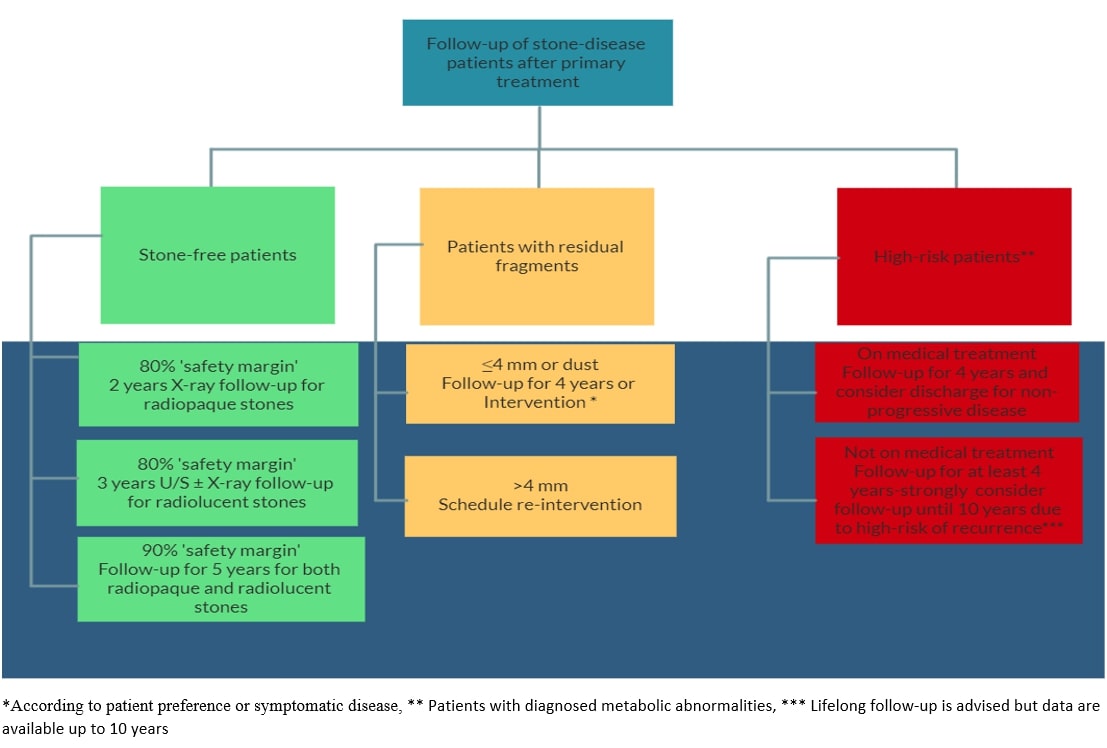Back
Poster, Podium & Video Sessions
Podium
PD50: Stone Disease: Epidemiology & Evaluation II
PD50-01: Duration of follow-up and timing of discharge in adult patients with urolithiasis after surgical or medical intervention: a systematic review and meta-analysis from the European Association of Urology Guideline Panel on Urolithiasis
Sunday, May 15, 2022
3:30 PM – 3:40 PM
Location: Room 255
Lazaros Tzelves, Athens, Greece, Robert Geraghty, Newcastle, United Kingdom, Riccardo Lombardo*, Rome, Italy, Niall D Davis, Dublin, Ireland, Andreas Neisius, Trier, Germany, Ales Petřík, Prague, Czech Republic, Giovanni Gambaro, Verona, Italy, Christian Türk, Vienna, Austria, Kay Thomas, London, United Kingdom, Bhaskar Somani, Southampton, United Kingdom, Andreas Skolarikos, Athens, Greece
- RL
Podium Presenter(s)
Introduction: No algorithm or guidelines are available for structured follow-up of urolithiasis patients. Therefore, we aimed to systematically evaluate literature on urolithiasis follow-up and provide a discharge time-point according to a patient’s stone-related status defined as either ‘stone-free’ or with ‘residual fragment(s)’.
Methods: A systematic review of Pubmed/Medline, EMBASE, Cochrane Library, clinicaltrials.gov was performed and reference lists of full-texts were reviewed according to the PRISMA statement using a search algorithm. Fifty studies were eligible (01/01/1970- 31/08/2021). Meta-analysis was performed with ‘’R’’ software, using ‘meta’ package for both randomized and observational trials due to lack of comparative trials on follow-up.
Results: From a pooled analysis of 5467 stone-free patients in 26 studies, patients should undergo follow-up with imaging for =2 years for radiopaque stones or =3 years for radiolucent stones to achieve a long-term stone-free ‘safety-margin’ of 80%. The stone-free safety margin increases to 90% after 5-years of follow-up without stone recurrence. For residual stone disease in 1274 patients, intervention rates ranged between 17-29%, disease progression between 9-34% and spontaneous passage between 21-34% at 49 months in patients with fragments =4mm. Intervention rates are higher (24-100%) in patients with residual fragments >4mm and elective intervention should be considered. There is insufficient data on high-risk stone forming patients, however literature dictates that patients who are adherent to targeted medical treatment experience less stone growth or re-growth of residual fragments and may be discharged after 36-48 months of non-progressive disease.
Conclusions: Follow-up of stone-free patients for 2-3 years is associated with long-term stone-free ‘safety-margin’ of 80%. The intervention rate in patients with residual fragments =4mm is low (29%) after 4-years and continued surveillance is an option. Finally, elective intervention should be considered for residual fragments >4mm as re- intervention rates are high.
Source of Funding: None

Methods: A systematic review of Pubmed/Medline, EMBASE, Cochrane Library, clinicaltrials.gov was performed and reference lists of full-texts were reviewed according to the PRISMA statement using a search algorithm. Fifty studies were eligible (01/01/1970- 31/08/2021). Meta-analysis was performed with ‘’R’’ software, using ‘meta’ package for both randomized and observational trials due to lack of comparative trials on follow-up.
Results: From a pooled analysis of 5467 stone-free patients in 26 studies, patients should undergo follow-up with imaging for =2 years for radiopaque stones or =3 years for radiolucent stones to achieve a long-term stone-free ‘safety-margin’ of 80%. The stone-free safety margin increases to 90% after 5-years of follow-up without stone recurrence. For residual stone disease in 1274 patients, intervention rates ranged between 17-29%, disease progression between 9-34% and spontaneous passage between 21-34% at 49 months in patients with fragments =4mm. Intervention rates are higher (24-100%) in patients with residual fragments >4mm and elective intervention should be considered. There is insufficient data on high-risk stone forming patients, however literature dictates that patients who are adherent to targeted medical treatment experience less stone growth or re-growth of residual fragments and may be discharged after 36-48 months of non-progressive disease.
Conclusions: Follow-up of stone-free patients for 2-3 years is associated with long-term stone-free ‘safety-margin’ of 80%. The intervention rate in patients with residual fragments =4mm is low (29%) after 4-years and continued surveillance is an option. Finally, elective intervention should be considered for residual fragments >4mm as re- intervention rates are high.
Source of Funding: None


.jpg)
.jpg)